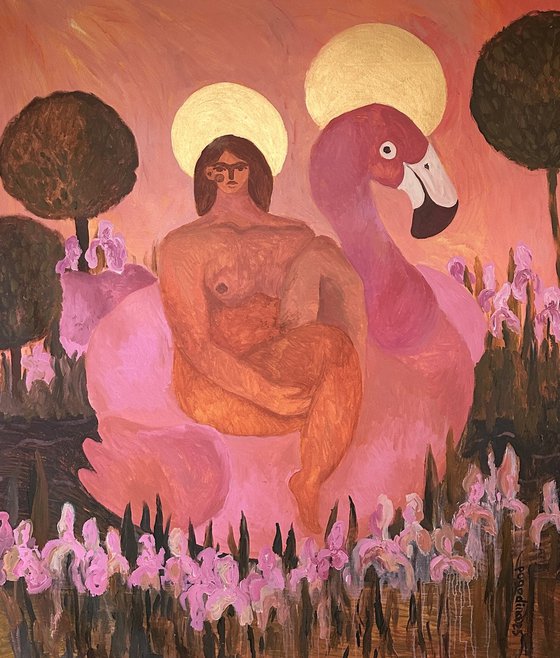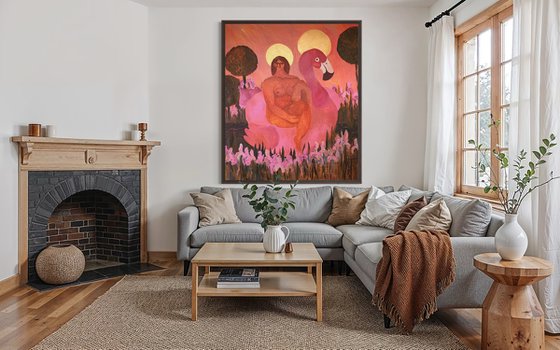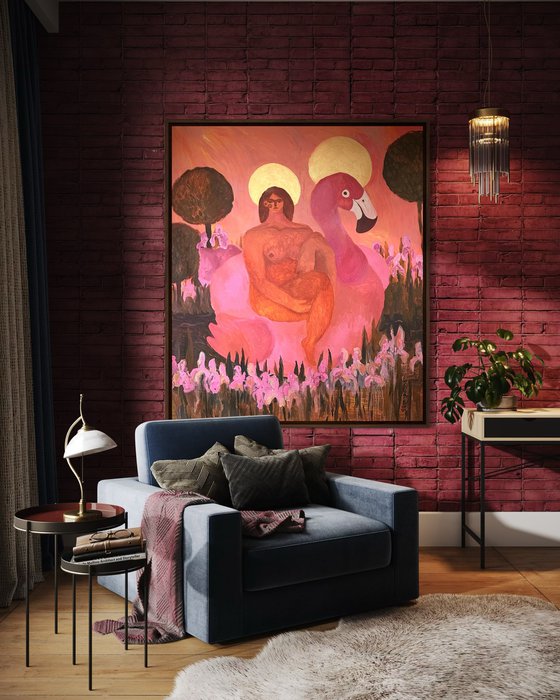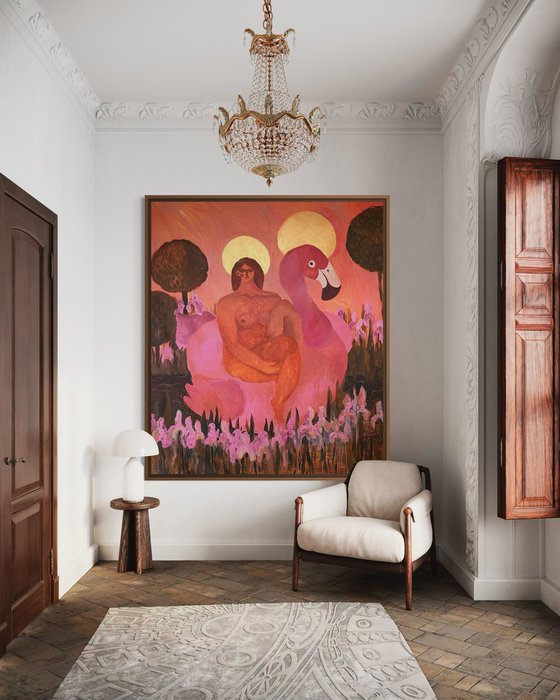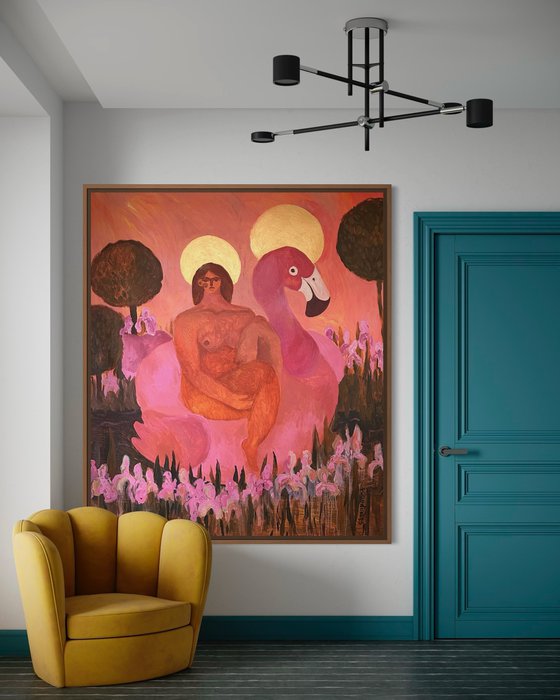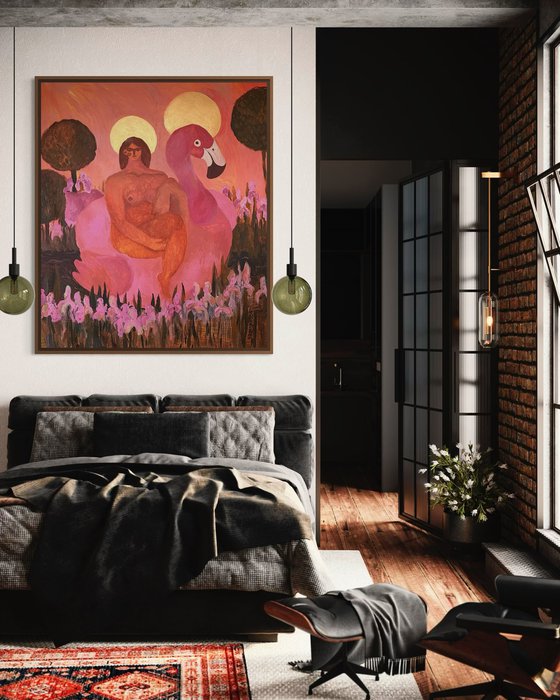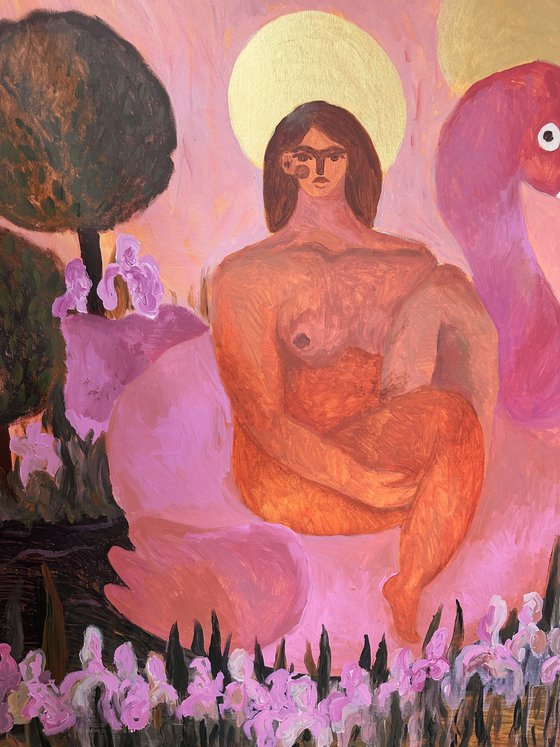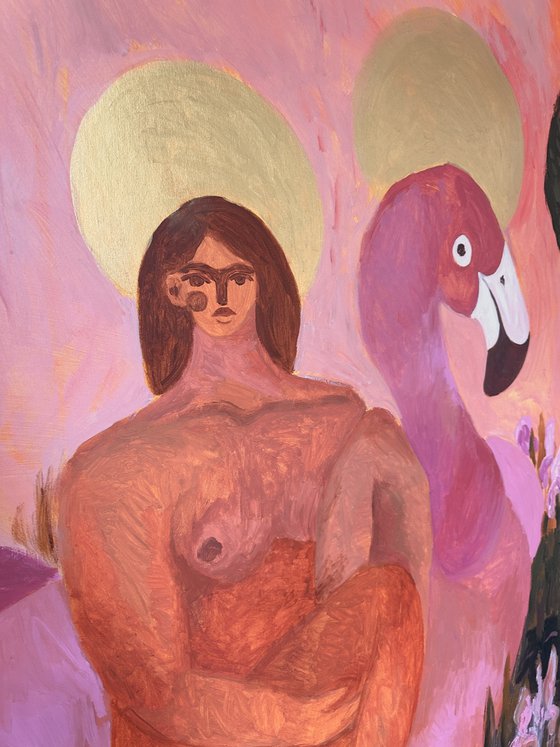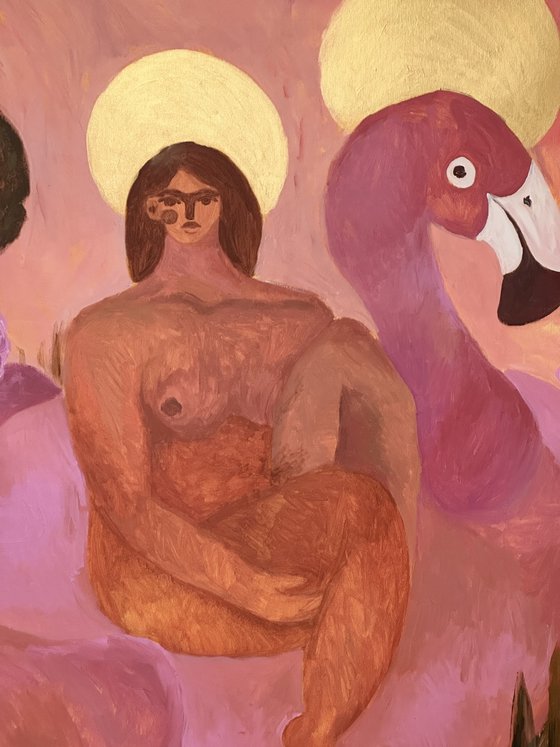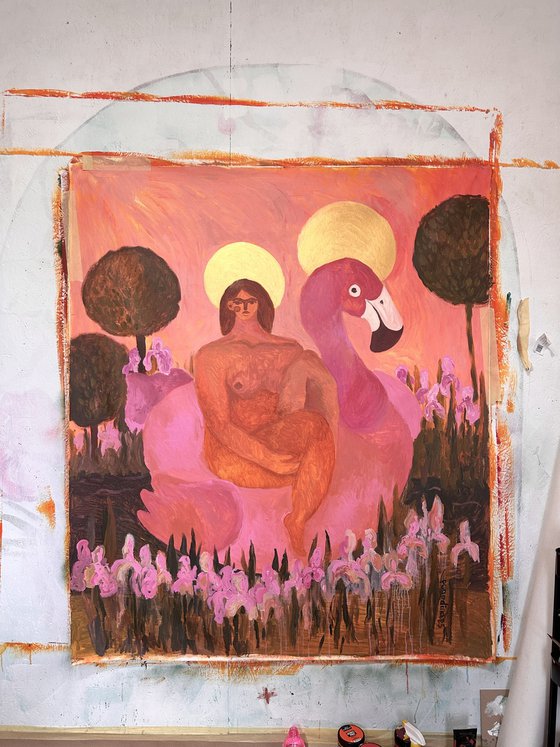Main Navigation
Original artwork description:
ABOUT THE ARTWORK
“Virgin Maria in the Garden”
from the series “Perichoresis”
In this work, the artist turns to the image of the Virgin Mary as an archetype of both female transcendence and earthly corporeality. The painting explores the fragile and paradoxical moment between the sacred and the mundane, between the fairytale-like and the bodily, between inner consent and external absurdity.
The heroine is placed in a garden — a symbol of solitude, fertility, and the mystery of birth. The garden, in this context, is not merely a background but a state of the soul, an inner world where a woman can truly hear herself. Nature here is an ally, a space where there is no need to justify one’s body, one’s desire, or one’s spirituality.
The pink flamingo seated beside the heroine embodies the incredible, the impossible, the absurdly miraculous. It does not mock, but elevates. Paired with the woman, it becomes a symbol of accepting the inexplicable but livable: the acceptance of destiny, of one's uniqueness, of the gift of being a woman. Their halos place them on equal footing in sacred status — no living being is accidental, no choice is devoid of holiness.
This painting raises questions about what female identity means in the context of the sacred — how the body can be a temple even when it defies canon or expectation, and how a woman can remain holy despite seemingly absurd circumstances. Here, motherhood is no longer literal — it becomes a symbol of creation and the acceptance of one’s unique nature.
PERICHORESIS SERIES
“Perichoresis” (ancient Greek περιχώρησις - “interpenetration”), a theological term meaning the mutual penetration of divine parts into each other, to describe a unique union that does not imply mixing or merging, but emphasizes an indivisible unity.
Daria explores the theme of new sexuality, deliberately choosing a term from theological treatises for her series of works.
With this gesture, she protests against the dictates of religion, the church’s manipulation and pessimization of human sexual manifestations and physicality, the false meanings and concepts with which religions have burdened, and instead of building true connections and bridges for man and God, they build walls.
“Perichoresis” for her is a beautiful and complex term that describes the fusion of the divine and the material. Having grown up in the Protestant tradition within an Orthodox society, Daria notes the common separation of sexuality from divinity in all these religions, while she sees sexuality as the clearest manifestation of divinity, beauty, and sublimity.
The artist notes that Christian culture has invested the image of the female body with a narrative of pornographic tension, while at the same time presenting paradise before the Fall as a sexual paradise, the Garden of earthly pleasures. For the artist, sexual paradise is a safe environment, complete trust, acceptance, the opportunity to open up and discover the Other, the opportunity to learn to be loved and to love.
Love is an environment where merging does not dissolve in another person, but on the contrary, strengthens the individuality of each and enriches each other.
Thus, the artist reminds that the division into the sublime and the low in love is artificial, and overcoming this division can make life more beautiful. The heroes of her paintings are immersed in the enigmatic space of love, and sometimes there are ironic scenes that balance the degree of sublimity.
Materials used:
Acrylic
Tags:
#figurative #girl #woman artworkVirgin Maria in the Garden (2025) Acrylic painting
by Dasha Pogodina
7 Artist Reviews
£2,207.15
- Acrylic painting on Canvas
- One of a kind artwork
- Size: 130 x 150 x 2cm (unframed) / 130 x 150cm (actual image size)
- Signed on the front
- Style: Impressionistic
- Subject: People and portraits
Loading
Original artwork description
ABOUT THE ARTWORK
“Virgin Maria in the Garden”
from the series “Perichoresis”
In this work, the artist turns to the image of the Virgin Mary as an archetype of both female transcendence and earthly corporeality. The painting explores the fragile and paradoxical moment between the sacred and the mundane, between the fairytale-like and the bodily, between inner consent and external absurdity.
The heroine is placed in a garden — a symbol of solitude, fertility, and the mystery of birth. The garden, in this context, is not merely a background but a state of the soul, an inner world where a woman can truly hear herself. Nature here is an ally, a space where there is no need to justify one’s body, one’s desire, or one’s spirituality.
The pink flamingo seated beside the heroine embodies the incredible, the impossible, the absurdly miraculous. It does not mock, but elevates. Paired with the woman, it becomes a symbol of accepting the inexplicable but livable: the acceptance of destiny, of one's uniqueness, of the gift of being a woman. Their halos place them on equal footing in sacred status — no living being is accidental, no choice is devoid of holiness.
This painting raises questions about what female identity means in the context of the sacred — how the body can be a temple even when it defies canon or expectation, and how a woman can remain holy despite seemingly absurd circumstances. Here, motherhood is no longer literal — it becomes a symbol of creation and the acceptance of one’s unique nature.
PERICHORESIS SERIES
“Perichoresis” (ancient Greek περιχώρησις - “interpenetration”), a theological term meaning the mutual penetration of divine parts into each other, to describe a unique union that does not imply mixing or merging, but emphasizes an indivisible unity.
Daria explores the theme of new sexuality, deliberately choosing a term from theological treatises for her series of works.
With this gesture, she protests against the dictates of religion, the church’s manipulation and pessimization of human sexual manifestations and physicality, the false meanings and concepts with which religions have burdened, and instead of building true connections and bridges for man and God, they build walls.
“Perichoresis” for her is a beautiful and complex term that describes the fusion of the divine and the material. Having grown up in the Protestant tradition within an Orthodox society, Daria notes the common separation of sexuality from divinity in all these religions, while she sees sexuality as the clearest manifestation of divinity, beauty, and sublimity.
The artist notes that Christian culture has invested the image of the female body with a narrative of pornographic tension, while at the same time presenting paradise before the Fall as a sexual paradise, the Garden of earthly pleasures. For the artist, sexual paradise is a safe environment, complete trust, acceptance, the opportunity to open up and discover the Other, the opportunity to learn to be loved and to love.
Love is an environment where merging does not dissolve in another person, but on the contrary, strengthens the individuality of each and enriches each other.
Thus, the artist reminds that the division into the sublime and the low in love is artificial, and overcoming this division can make life more beautiful. The heroes of her paintings are immersed in the enigmatic space of love, and sometimes there are ironic scenes that balance the degree of sublimity.
Materials used:
Acrylic
Tags:
#figurative #girl #woman artwork14 day money back guaranteeLearn more
